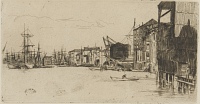Etchings Institutions search term: grolier club
Free Trade Wharf | ||
| Number: | 171 | |
| Date: | 1877 | |
| Medium: | etching and drypoint | |
| Size: | 99 x 186 mm | |
| Signed: | butterfly at lower left (3-final) | |
| Inscribed: | no | |
| Set/Publication: | Fine Art Society, 1879? | |
| No. of States: | 8 | |
| Known impressions: | 33 | |
| Catalogues: | K.163; M.160; W.134 | |
| Impressions taken from this plate (33) | ||
TECHNIQUE
The composition was first etched and then drypoint was used to add reflections and clouds, to give a softer and more atmospheric feel to the scene.
PRINTING
When an impression was sold in October 1877, Whistler wrote a code of letters and dots ( 'x . . . . .') that probably meant that he had five impressions. 9 However, this numbering does appear on the other early impressions that have been traced.
An impression of the second state, owned by Samuel Putnam Avery (1822-1904), was printed in black ink on ivory laid paper with a partial 'DE ERVEN DE BLAUW' watermark ( ). Wedmore commented :
). Wedmore commented :
An impression of the second state, owned by Samuel Putnam Avery (1822-1904), was printed in black ink on ivory laid paper with a partial 'DE ERVEN DE BLAUW' watermark (
 ). Wedmore commented :
). Wedmore commented : 9: Whistler to M.B. Huish, 10 October 1877, GUW #12734.
'Etched in 1877, and issued by the Fine Art Society in an edition of a hundred impressions, printed by Goulding, Whistler having himself previously printed two or three impressions, more delicate and perfect - of which Mr. Avery has one, and I another.' 10
10: Wedmore 1886 A (cat. no. 134).
Curiously, no impression of the first, third or fifth states has been located. 11 It is possible Whistler (or an assistant) kept proofs of these states before he approved an impression for publication.
11: Kennedy 1910 (cat. no. 163 I, IIa, IV/V).
In 1879 the plate was printed for the Fine Art Society by Frederick Goulding (1842-1909): an impression of the fourth state is signed 'Coll F. Goulding Imp.' and was inscribed by Whistler 'Bon à tirer' ( ) meaning it was approved by the artist for printing. It was printed with warm black ink on cream Japanese paper, with light overall tone. It was bought by Albert Henry Wiggin (1868-1951), and passed to Boston Public Library.
) meaning it was approved by the artist for printing. It was printed with warm black ink on cream Japanese paper, with light overall tone. It was bought by Albert Henry Wiggin (1868-1951), and passed to Boston Public Library.
 ) meaning it was approved by the artist for printing. It was printed with warm black ink on cream Japanese paper, with light overall tone. It was bought by Albert Henry Wiggin (1868-1951), and passed to Boston Public Library.
) meaning it was approved by the artist for printing. It was printed with warm black ink on cream Japanese paper, with light overall tone. It was bought by Albert Henry Wiggin (1868-1951), and passed to Boston Public Library.Supposedly there were a hundred impressions of the fourth state published by the Fine Art Society, but in fact less than a quarter of these have been located, and it is possible the planned print run was cut short. These were printed on a variety of papers. Most are printed - like the Goulding impression mentioned above - in black ink. Western papers include cream laid, possibly with a shell watermark ( ); ivory laid with an obscure countermark (
); ivory laid with an obscure countermark ( ); ivory 'antique' (pre-1800) laid (
); ivory 'antique' (pre-1800) laid ( ,
,  ), the latter again having an indecipherable watermark. Asian papers include off-white light-weight Japanese (
), the latter again having an indecipherable watermark. Asian papers include off-white light-weight Japanese ( ); ivory Japan (
); ivory Japan ( ) and cream tissue-like Japan (
) and cream tissue-like Japan ( ). Some, however, were printed in dark brown ink, again on both western and Asian papers including cream Japanese paper (
). Some, however, were printed in dark brown ink, again on both western and Asian papers including cream Japanese paper ( ); off-white laid paper with 'CDG' watermark (
); off-white laid paper with 'CDG' watermark ( ); cream laid (
); cream laid ( ) and cream laid paper with a countermark of illegible initials (
) and cream laid paper with a countermark of illegible initials ( ).
).
 ); ivory laid with an obscure countermark (
); ivory laid with an obscure countermark ( ); ivory 'antique' (pre-1800) laid (
); ivory 'antique' (pre-1800) laid ( ,
,  ), the latter again having an indecipherable watermark. Asian papers include off-white light-weight Japanese (
), the latter again having an indecipherable watermark. Asian papers include off-white light-weight Japanese ( ); ivory Japan (
); ivory Japan ( ) and cream tissue-like Japan (
) and cream tissue-like Japan ( ). Some, however, were printed in dark brown ink, again on both western and Asian papers including cream Japanese paper (
). Some, however, were printed in dark brown ink, again on both western and Asian papers including cream Japanese paper ( ); off-white laid paper with 'CDG' watermark (
); off-white laid paper with 'CDG' watermark ( ); cream laid (
); cream laid ( ) and cream laid paper with a countermark of illegible initials (
) and cream laid paper with a countermark of illegible initials ( ).
).
